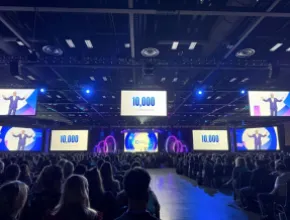When Matthew Cunningham, age 32, was offered a job as events manager with the American Petroleum Institute (API) in Washington, D.C., last year, he was told he’d been hired for his youthful perspective as well as his industry experience. But since starting the job in January, he’s encountered planning challenges that can only be tied to that industry’s generational divide.
“We certainly have a lot of the old J.R. Ewing types who have been doing oil for a long, long time,” he says. “They are pretty set in their ways, resistant to change, and anything too flashy turns them off. Then we have the younger guys. If I don’t make events flashy they won’t come back next year.”
Even choosing meeting sites finds Cunningham diving headlong into the generational divide.
“The older guys like a destination that’s convenient to airports and close to their offices,” he says. “The younger guys want to go some place that’s fun. So I have to find something in the middle.”
Then there are communications differences. Cunningham says younger attendees want everything online, while the older ones go for paper handouts. Marketing is challenging, too. He’s doing lots of online event marketing, but many members of his older attendee base have assistants who do all their e-mail, so it’s hard to get meetings in front of them.
The oil industry needs more young people to replace those who are retiring, he says, but meetings are one thing that must change if that is to happen.
Future Shifts
For event planners like Cunningham, the future is now. For others, demographic quakes in the workplace, and thus meetings, are the elephant in the room they’ve either ignored or haven’t yet noticed.
Historically, the American economy has leaned on the 20-to-64 age group as its primary labor source. Around 2010, however, the workplace shift will escalate, resulting in a large increase in the 65-and-over age group and a big decline in the number of younger workers.
By 2015, statisticians say the number of those entering the 65-and-over age group will start to grow at a faster rate than the youngsters. Labor shortages are predicted, yet some organizations will retain older workers to mind the gap. Also, some will want to stay because they can’t afford to retire, or they simply enjoy their work and don’t want to leave just because they’ve hit the magic number of 65.
Try to imagine your 2020 meetings audience—real or virtual. If what you have pictured follows the statistics, there’s the likelihood that tech-obsessed Gen X and Y people will be sitting next to aging Boomers with sensory barriers against absorbing what you want to communicate. Those younger delegates will be out front, too, supervising people old enough to be their grandparents.
It’s like there will be four or five generations in need of continuing professional education.
In her “The Future of the Meetings Industry: Impact and Actions” presentation at this year’s HSMAI Affordable Meetings programs in Chicago, Washington, D.C., and San Jose, Calif., Joan Eisenstodt, chief strategist of Washington, D.C.-based Eisenstodt Associates, with futurist Marsha L. Rhea, CAE, senior futurist for the Institute for Alternative Futures, discusses multi-demographic learning sessions.
“We assume people learn and respond the same way, but they don’t,” Eisenstodt says. “We must determine what grabs the various generations and bring them into different ways of thinking and learning.”
People of any age have different learning styles and preferences, including oral, visual and tactical. Some want to touch and feel keyboard or paper; others just want to hear a lecture. What may be an order for meetings in 2020 then, she suggests, is customization. A session on any given topic may get presented in three or more different ways, or a combination.
Customized for Effect
Mary Tomlinson, president of On-Purpose Partners, an Orlando, Fla.-based consulting, training and coaching firm, also believes customized meetings may be the way of the future.
If customization is not practical, she recommends going with what the majority want. In any case, she believes the generational mix should prompt planners and facilitators to become students of their constituencies as never before, and to improve their communication skills. Above all, by 2020 boring meetings will be tolerated less than now.
“Younger people don’t want us to waste their time,” Tomlinson says. “They expect productive, energized meetings, while older people have lower expectations because they’ve been subjected to boring meetings for so long. Youngers who have lived their entire lives with a computer mouse in their hands want a ‘let’s do it now, make the decision and move on’ kind of atmosphere.”
Meetings industry technology expert Corbin Ball, CSP, CMP, president of Bellingham, Wash.-based Corbin Ball Associates, also believes customized meeting formats will be the way of the future, comparable to magazines for various niche markets. Users define how they want to get where they want to go, he says, but much of the interaction will remain face to face.
“Meetings will remain viable in the future,” Ball contends, “because we are social animals and need to touch, feel and experience things. Because we have biological imperatives such as hunger, curiosity and companionship, we will continue to have dinner parties, entertain in groups, exchange ideas, brainstorm, and nurture relationships in both our personal and business lives.”
Information data—from books, manuscripts, film, TV, photography, and other media—will be digitized and the computer generations will be most adept at gleaning it, he predicts. Yet there will always be the need for creative people of any age to sort it all out for the rest of the group.
“Articulate people with vision and passion won’t go away, and they may be needed even more,” Ball says. “While it’s true that the generations look at data differently, based on their own histories, they should collaborate about the best way to approach work. Boomers who have a hard time dealing with tech should seek out a younger worker for help.
Youngers should look to Boomers, who have lots to tell young people about how you deal in business. They should mentor one another.”
Olders in 2020 meetings will require some accommodation, however.
“We will still be seeing the influence of Boomers in 2020, and planners will have to make ready for their visual, hearing and other physical impairments,” Ball warns.
Trade Show Alternatives
Increased digitization of information and generational changes in the next decade-plus will bring drastic alterations in trade shows, Ball predicts. Commodity shows have already been affected by disintermediation—removal of the middleman in the sales process. People shop and buy online, at lesser cost to sellers, and that will only grow in the future. Yet service sells best in person.
“Humans still need service industries,” Ball says, “so the efficiencies in consolidating service vendors in one show location to build relationships with potential buyers will still work.”
But how will such shows serve multiple generations in attendance?
Charles W. Allen, chairman and CEO of Birmingham, Ala.-based C.W. Allen Group, a trade show and event consultancy on the forefront of cutting-edge programming, believes that trade shows and meetings of the future must make people want to attend if they are to survive.
“It’s the No. 1 rule of show business,” Allen says. “You always want to leave the audience wanting more. This means interactive educational opportunities at events must increase so that if you want the experience, you must show up to get it—it can’t be something you can get off your computer or PDA.”
Ancillary entertainment choices—“expotainment”—will have to increase along with the learning experiences, he predicts.
“People are motivated to the extent they feel involved,” he continues. “Adults learn by doing, and if they are enjoying the learning process, they will have a meaningful experience. I see a trend to higher energy and a faster pace for both shows and meetings, because that’s what younger people want. Generations X and Y will rule, and Boomers who are still around will have to adapt by 2020.”
Power Presentations
Presentations at shows and elsewhere by 2020 must be sharp and interactive, maintains Ann A. Fishman, president of New Orleans-based Generational-Targeted Marketing Corp.
“Forty-five minute presentations and motivational speakers will be a thing of the past,” she says. “X and Y are already empowered. Y’s all expect to be president or CEO, so to hook them, you must make like the scrolling page. Educational sessions will provide a myriad of speakers who make their points and leave. Xers are cynical and they want short and concise. They aren’t impressed by celebrities, so save your money. They are interested in learning how the game is played, so give them something they can’t get off the Internet, like how someone got ahead in corporate America. They are thirsty for the mentoring they never had.
“Y’s want you to be interactive,” Fishman continues. “They like Q&A formats and they expect you to ask their opinion—maybe text messaging during the presentation. Y’s were given everything X’s were denied, so give them something of substance.Again, something they can’t get on the Internet. Both of these generations want short, snappy and full of life experiences. Use highly visual and bulleted formats.”
Eisenstodt agrees with Fishman. Talking heads often function as if they are talking to a grove of trees, she opines. The interminable PowerPoint presentation of today just won’t cut it. To be relevant, meetings of the future should be preceded by learning inventories. There will be novice, intermediate and expert tracks, Eisenstodt says, but customized to learning modes.
“We must do more pre- and post-session work via electronics,” she says. “And we must use various formats geared to how people learn. For oral learners—those who need to talk and ask questions out loud and hear discussion—we will have that. Others may need to write it all down on keyboard or paper.”
API’s Cunningham likes the idea of interactive educational sessions in which attendees share ideas. Theater-in-the-round setups could work much of the time, he believes, during which speakers present a real-world experience then take questions about it from attendees.
Separation for Satisfaction
Yet, to state something of the obvious, there are times when the generations do best if they are separated at events.
“Younger people want different music and different drinks from what older people want,” Cunningham says. “They like hamburgers and pizza, not fancy gourmet menus. They don’t need salads before a meal, and that saves me on F&B anyway. Barbecues can go over well with multiple ages, like the one we did recently on Hilton Head Island. But we are now doing events targeted to younger people. For networking, we do two receptions, one for the younger we call ‘Young Professionals Reception’ and another for older people. That works well.”
Generational Students
Futurists like Tomlinson and Fishman advise planners to study generational differences, embrace them, and use them to maximum advantage for coloration of meetings.
“Don’t be afraid of the generations mix,” Tomlinson says. “Embrace it and use it to your advantage to make your event more interesting. Lots of energy comes from blending experience. So while the 2020 culture may be more challenging, the outcome can be very dynamic and creative.”
The most effective planners will spend time getting into the heads of the constituencies they serve, she advises. They will know their audiences both demographically and psychologically, and then they’ll be able to mount events that will engage them whether they be 32 or 72.





